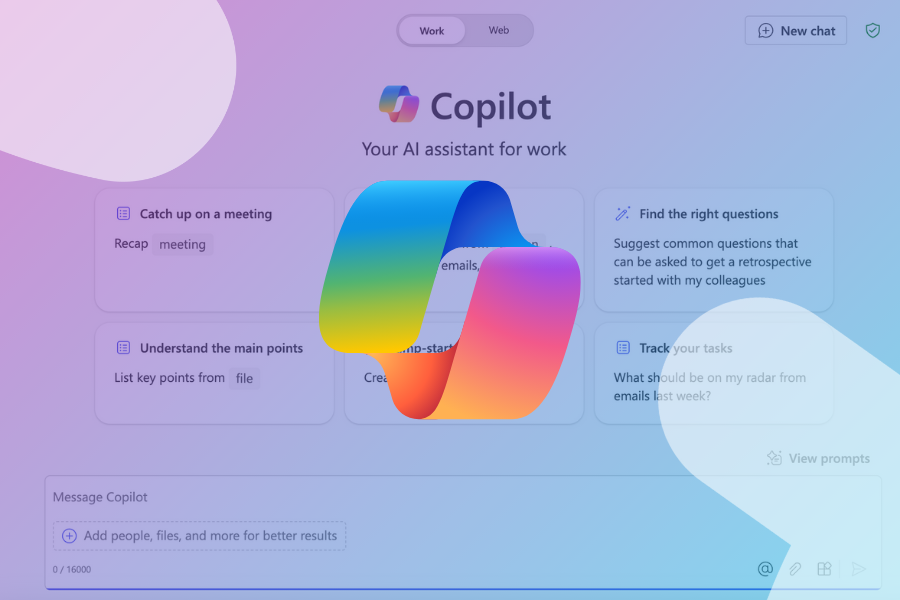Get the most out of Copilot for Microsoft 365 with our Copilot Prompting Guide!
Copilot for Microsoft 365 is built for professionals and organizations, designed to integrate directly into the M365 apps you know and love:
- Microsoft Teams
- Outlook
- Word
- Excel
- PowerPoint
- and more!
It leverages large language models (LLMs) and organizational data to help you improve productivity in tasks such as drafting documents and emails, catching up on emails or chat threads, creating presentations, and analyzing data.
By automating routine tasks and providing intelligent insights, Microsoft 365 Copilot aims to help you focus on the work that matters most to your business.
Microsoft 365 Copilot Prompt Guide
In this guide:
- What is a prompt?
- What makes a Copilot prompt effective?
- 4 Key Prompt Ingredients: Your Recipe for Success
- Keep the conversation going
- Resources
What is a “prompt”?
A prompt is the question or instruction you give to Microsoft 365 Copilot, indicating your desired action or response. Your prompt plays a crucial role in determining the quality of the resulting response. Providing clear and specific prompts can enhance the overall interaction with the tool.
What makes a Copilot prompt effective?
- Be specific and detailed in your prompts
- Vague or simple prompts will likely result in less helpful answers. Remember, Copilot has the “brain” power to process more complex requests.
- Write your prompt in full sentences with instructions.
- Copilot is built on natural language processing technology that allows it to understand the context around your request. Full sentences often include context you might not even consciously recognize.
- State the tone, purpose, and preferred format of the response you want
- Tell Copilot how you want its response delivered. The more detailed you are in this, the more likely you are to get an accurate answer.
Remember: There are no “wrong” prompts because natural, conversational language is welcome. Prompting AI to generate responses is not an exact science! The key is iteration and knowing that there are multiple ways to approach a prompt. You may just need to experiment until you find what works best.
4 Key Prompt Ingredients: Your Recipe for Success
Let’s break down the anatomy of a prompt by taking a look at an example:
Generate 3-5 bullet points
to prepare me for a meeting with Client X to discuss their “Phase 3+” brand campaign.
Focus on Email and Teams chats since June.
Please use simple language so I can get up to speed quickly.
In this example, you can see that we’ve broken this prompt down into four parts:
1. Goal
What response do you want from Copilot?
Focus on the outcome you want, and be specific!
2. Context
Why do you need it, and who is involved?
Imagine you are explaining a task to an assistant or coworker. What extra details would they need to get started? Does Copilot have those details?
3. Source
Which information sources or samples should Copilot use?
If applicable, you should tell Copilot where to look for information to support its response. If you have a Copilot for Microsoft 365 license, your sources could include content from the web, AI-powered web search, or internal corporate content stored in apps like Teams, SharePoint, OneDrive, or Outlook/Exchange.
Remember, data protection must be considered when setting up Copilot for Microsoft 365. For more information, see my recent blog, Navigating Security in Copilot for Microsoft 365: Avoiding the Pitfalls of Oversharing.
4. Expectations
How should Copilot respond to best meet your expectations?
Finally, tell Copilot how you want its response delivered. In this example, we ask Copilot to use simple language. But you could also tell it that you would like a presentation or a numbered list of action items.
Keep the conversation going!

Don’t be satisfied with the first result you get from Copilot! I highly encourage you to continue refining the response given by Copilot by providing additional prompts. This process helps you get the most useful and tailored responses.
Resources to help you improve your prompting skills:
- Watch the full webinar, where Quisitive and Microsoft AI experts walk you through a full Guide to Copilot — don’t worry, it’s free!
- Experiment with Copilot Lab, a hub created by Microsoft where users learn how to work with AI within their organizations.
- Get the Prompt Buddy app, a PowerApp built for Microsoft Teams that allows organizations and teams to work collaboratively on and share their favorite prompts.
Ready to get started with Microsoft Copilot?
A new era of work has arrived. Artificial intelligence (AI) can transform your business by streamlining tasks, enhancing collaboration, and doing it faster. Is your organization ready to harness everything that Microsoft 365 Copilot has to offer? Find out with Quisitive’s Copilot Quick Start.

;)



